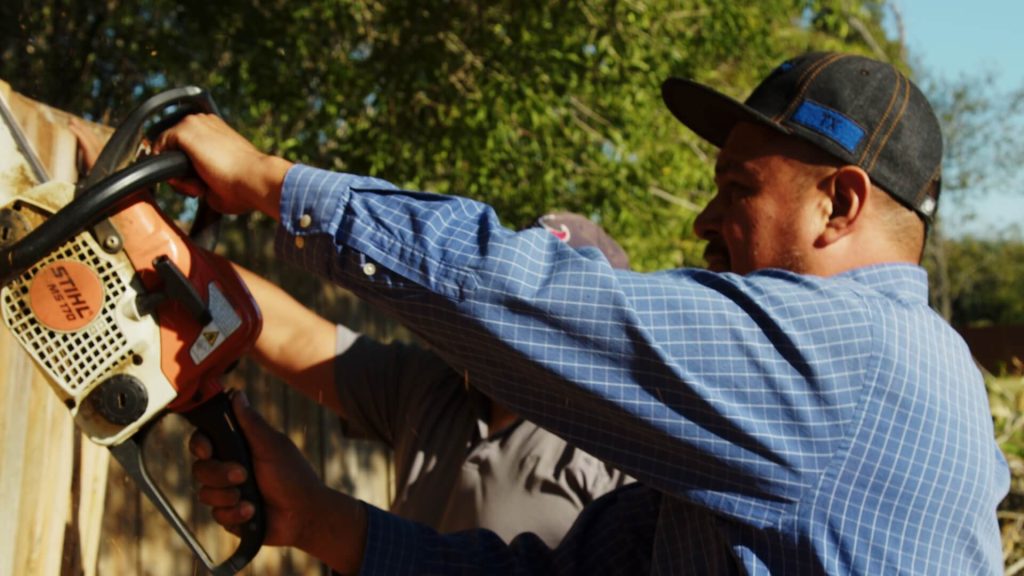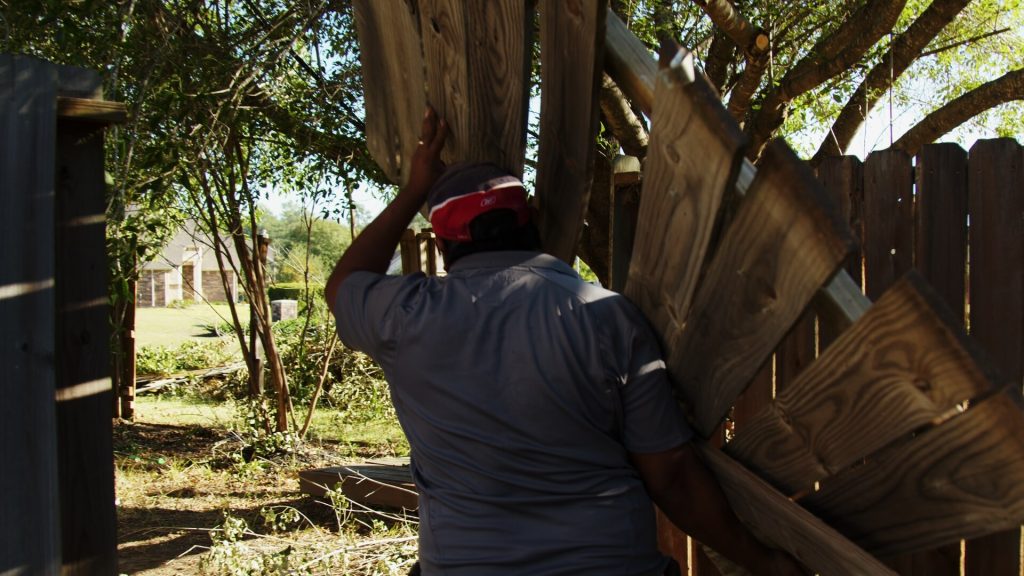Fence Repair and Replacement: Common Issues and Solutions
From droopy pickets and sagging rails to splintering panels and fraying cables, fence repair and replacement can be a daunting task, but it doesn’t have to be! Whether you’re dealing with a broken gate latch or a leaning post, the solutions to common fence issues are quite simple and readily available. In this blog post, we’ll explore the common problems people experience with their fencing and how to tackle them effectively and efficiently.

Common Fence Repair and Replacement Issues
Fence repair and replacement can sometimes be complicated tasks, because there are several factors that need to be considered. One of the most common issues associated with fence repair and replacement is determining the best materials to use for the job. Wooden fences can require special wood preservatives, paints, and waterproofing treatments, whereas chain link fences may need galvanization or vinyl coating.
It’s also important to consider the area around the fence – making sure soil levels are appropriate, drainage is adequate, and any other obstacles like vegetation or utility lines are considered.
Another common fence repair and replacement issue is identifying a properly licensed contractor who can do the job correctly. Many homeowners can take on DIY repairs assuming they have the right expertise, but even then, it’s recommended that they consult licensed fencing contractors to make sure their repairs are up to code. In addition, many local or state governments have ordinances that must be followed when repairing or replacing any type of fencing structure.
Finally, it’s important to factor in potential costs before beginning any fence repair or replacement project. Costs can range from buying top quality materials to paying for labor – which brings up another important issue – finding a reputable contractor at an affordable price point. As such, it’s essential for property owners needing these services to shop around for several quotes in order to find the best deal for their needs.
These are all common issues associated with fence repair and replacement, and due diligence can help alleviate many of the complications that come with it. It’s still important to inspect a structure carefully before proceeding with any repairs or replacements. Doing so ensures all issues are identified early on to avoid any major surprises later on down the road.
Inspect the Fence Carefully
Before tackling the task of repairing or replacing a fence, inspect it carefully. This is a great way to determine what issues need to be addressed and how much materials and labor will be needed for the job. When looking for problems, pay attention to every detail. Check for any signs of damage such as rotted wood, split boards, warping, chipping paint, broken connectors and hinges, dislodged post anchors, rusting metal components and loose nails. Additionally, look for leaning posts which can be an indication that the soil has shifted or eroded. This can cause a number of other problems if left unchecked.
In many cases, the extent of the repairs needed may not be obvious right away. If there is any doubt regarding what should be done or which materials are best suited to replace or repair damaged areas, it’s best to consult a professional fence installer or contractor who is knowledgeable in fencing systems. An expert’s opinion will give homeowners more information about their options so they can make an informed decision regarding repairs and replacements.
Having inspected the fence in detail and consulted with a professional, if necessary, homeowners will be able to better understand what needs to be done. From there they can weigh their options and begin looking into cost-effective solutions that allow them to maintain or upgrade their fencing system while staying within budget.
- According to a survey by Home Depot, posts rotting away is the most common problem with fencing, making up 40% of all fence repairs.
- Around 20% of fence problems are related to broken or missing boards.
- 17% of surveyed fence repair jobs were due to weather damage caused by strong wind, rain, and snow.
Recognize the Cost-Effective Solutions
Once you have completed an inspection of the fence, it is important to consider potential cost-effective solutions to repair or replace any damaged components. Depending on the extent of the damage, replacing individual parts may be more economical than replacing an entire section of the fence. In some cases, restoring a weathered fence might involve minor repairs such as screw replacements or sanding and painting, which can help revive your old fence without breaking the bank.
If a repair job requires more effort, such as repairing broken pickets or fixing metal hardware components, then it might be more cost effective to simply replace the part instead. Consider all your options to save money while still ensuring quality fixes.
When debating the two sides of this issue, both options should be considered carefully depending on the extent of damage. If complete replacement is necessary due to structural or weathering damage, then it may not be worth investing in costly repairs. However, if smaller repairs can bring your fence back to its previous condition with minimal effort and costs, then it would be wise for you to fix rather than replace it. Each situation should be weighed on its own merits and should involve careful consideration of material and labor costs involved in order to determine if repair or replacement is best.
Structural Issues and Weathering Damage
In considering repair and replacement of wood fences, it is important to also recognize potential structural issues and weathering damage. If a fence has been damaged by weather or normal wear and tear, its structure can become weakened. Wooden posts and boards can be particularly susceptible to rotting, warping, cracking, and splintering due to moisture buildup. As a result, the fencing can collapse or be easily broken apart with little force.
It is often worthwhile for homeowners to invest in preventive maintenance for their fencing as a cost effective solution to stave off major repairs or replacements. Taking time to provide regular care (such as re-staining and resealing) from season-to-season can help avoid more serious problems in the future. However, some may prefer to wait until structural damage occurs before conducting any repairs or restorations; this could be seen as the thriftier approach since immediate costs could be lower. Ultimately, it is up to the homeowner to determine which option best suits their repair needs.
No matter what approach they take, however, homeowners should be prepared to replace rotting posts and boards when necessary. Upgrading softwoods with pressure-treated lumber or other hardwoods can further extend the life of their fence while providing additional protection against environmental elements and pests. Keeping these considerations in mind can help ensure that the investment in a fence truly stands the test of time.
Replace Rotting Posts and Boards
When dealing with a fence that has seen better days, the condition of its posts and boards is a major factor in deciding to repair or replace. Rotten posts and boards are often caused by extreme weathering, such as flooding or excessive wetness, causing wood to become soft, discolored, or even completely eventually perish over time. Consequently, it is important to monitor the condition of your fence’s boards and posts regularly in order to stop issues from becoming too serious.
The key question is whether one should repair or replace the damage when faced with rotten posts and boards. On the one hand, some DIYers may see this as an opportunity for repairs; replacing individual parts of your fence can be a cost-effective solution because you only need to replace the sections that are rotten, which also allows you to retain individuality in your fencing structure. On the other hand, if the issue has become beyond repair– rusting fittings or external rot—it might be time to consider total replacement.
Ultimately, the best choice of action depends on how far gone the rotten components are and how much money you are willing to spend on repairs versus a full replacement. If you decide to repair rather than replace, then look at any signs of corrosion and decay—inspect both sides of each partition as well as all connectors—and then make sure all parts are tightened securely.
Regardless of deciding between replacement or repair, it is important to act quickly before something more serious occurs to your fence. Fortunately, many homeowners are presented with choices that can help their fences retain its long-term structural integrity and stability for years to come. However, it must be noted that deteriorating fasteners and fittings can create problems for fences over time if not treated quickly enough. As such, exploring options on how best address these kinds of problems is essential for making sure these components remain intact down the line.

Deteriorating Fasteners and Fittings
The next step in fence repair and replacement is to focus on deteriorating fasteners and fittings. Just as the posts and boards may rot over time, so too can door or gate hinges and screws loosen with the passing of each cold winter or hot summer day. Depending on who you ask, there are different perspectives on how to best approach this issue. Those favoring a more frugal approach might suggest simply re-tightening any loose screws, nuts, or bolts in order to extend the life of their product. Meanwhile, those wishing for more of a permanent solution may opt for replacing all affected metal pieces with new ones.
Regardless of what route is taken, one thing is certain: there must be a thorough examination of the entire fence and gate structure before deciding which option makes the most sense in each individual situation. Consumer Reports has recently recommended inspecting hardware regularly and checking for signs of wear such as rust or corrosion. After that, if it warrants further action then deciding between tightening and replacement will be an easy one that’s based on both cost and desired longevity.
With proper care given to both posts and boards as well as fasteners and fittings, your fence can remain a protective asset for many years to come. But because no material lasts forever, it’s important to keep an eye out for issues that could potentially lead to damage down the line – such as fascia boards or gate repair needs. Addressing them now can often prevent future needs from stemming from the same problems.
Fascia Boards and Gate Repair
When addressing fence repair and replacement, it is not just the fasteners and fittings that should be assessed for deterioration. Fascia boards, which typically run along the top of the fence line, as well as gates, can present with similar problems over time from exposure to the elements.
When repairing a gate or fascia board due to deteriorating material, it is important to evaluate if a patch solution, such as replacing damaged sections with new material and fasteners, is possible or if an entire replacement is necessary. Patches can extend the lifespan of a gate or fence line by years, but also require general upkeep in order to remain secure and aesthetically pleasing throughout its lifespan. On the other hand, a full replacement may be more suitable and provide greater cost savings in the long-term if a fence panel or gate has become severely damaged.
This can be a difficult decision to make, however both options have upsides – patchwork solutions are more economical in the short term and allow homeowners to save on costs while full replacements are often sturdier and last longer in comparison to patch solutions.
No matter which option you choose for repairing your fascia boards or gates, good safety practices should always be followed when working with power tools and ladders. Proper planning before beginning any repairs ensures that all DIY projects are completed properly and up to building codes. Washed away by rain and sun of season past, it’s important also to consider any rot or decay when assessing fence repair and replacement needs. Such issues should not be ignored as they could lead to far bigger problems down the road if left untreated.
Decay and Cracks in The Wood
When assessing a property, it is important to look out for cracks and decay on wood materials as these issues can rapidly deteriorate the integrity of the fence. Wood materials are most susceptible to water damages and structural flaws because of their organic composition. Fence posts are especially vulnerable to weathering due to their continuous exposure and contact with the soil, so close monitoring is necessary. In evaluation, any wood that shows signs of grey coloring or splitting can be a sign of decay caused by insects, fungi, or molds. Once decay has set in, repair may not be possible and replacement of the affected material will be necessitated.
Sometimes, there may even be hairline cracks present in the wood which can cause major problems if left untreated. Wood splits over time due to extreme or fluctuating temperatures or pressure changes but often times these issues can be caught early on before they grow further by keen observation and preventive maintenance care. In the case of wide crack developments, replacing the broken piece with new material would eliminate further faults in its integrity and enhance the appearance of the fence overall.
Therefore, being vigilant to spot cracks and signs of decay can help to quickly identify weakness in a structure’s integrity before they become unmanageable problems that require substantial repair costs. To ensure an attractive outcome in fence repair and replacement it’s important to find attractive solutions for these common issues before we move onto other potential solutions for achieving aesthetic goals.
Attractive Solutions for Attractive Outcomes
The purpose of building a fence is to add aesthetic charm and privacy to your home. Therefore, the outcome should always be an attractive result that suits your tastes. When deciding on how to repair or replace a fence, it’s important to consider the techniques and materials used to ensure the result is attractive.
The most conventional options for repairing and replacing fences include wood, metal, and vinyl. Each option has its benefits and drawbacks; however, all are proficient in providing a beautiful outcome when done correctly.
Wood remains one of the most popular materials for both repairs and replacements due to its affordability and variety of styles. Homeowners can choose from a wide range of species such as pine, cedar, and redwood that are available in countless finishes to achieve the desired look they want. Additionally, wood offers the unique benefit of being able to be stained or painted – allowing owners to customize their fence according to their preferences.
On the other hand, metal fencing is quickly becoming an increasingly popular choice among homeowners due to its durability, low maintenance requirements, and variety of designs. For example, aluminum fencing is one of the most popular types of metal fencing due to its strength yet lightweight nature which can accommodate more intricate detailing when compared with wood fencing. It also comes in numerous colors so homeowners can choose a finish that fits their taste.
Finally, vinyl fencing is another viable option for homeowners looking for an attractive solution that requires very minimal maintenance throughout its lifespan. Vinyl fencing comes in various colors and will not fade over time – making it ideal for those looking for a long-term solution where little effort is required in upkeep or repairs. Unlike its counterparts, however, vinyl fencing often has limited appearance options since it is pre-built and made ready for installation.
No matter which material you choose for your fence repair or replacement project, there are plenty of options available on the market to create an aesthetically pleasing outcome – so you can make sure you end up with just what you had envisioned right from the start!








